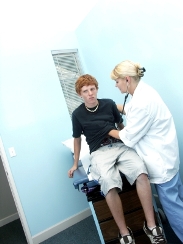The medical community is largely unaware of national sports preparticipation physical evaluation (PPE) guidelines and only 11% of athletes at US high schools are guaranteed to receive a PPE fully consistent with the national standard, finds a 2014 study.
The findings come despite the 2010 endorsement of 6 national medical societies of a single PPE form as part of an effort to standardize the screening process, and nearly unanimous public support for PPE screening by a qualified health care professional before participation in a consistent manner across the country. (PR Newswire, 2012)
The release of the study also comes on the heels of the issuance by the National Athletic Trainers' Association of a position statement calling for a standardized process for conducting the preparticipation physical examination is needed to ensure a safe playing environment for athletes and to help identify those conditions that may predispose an athlete to injury or sudden death,
"Despite the apparent desire for uniform guidelines by the necessary stakeholders, there remains an implementation gap that has not been resolved by formal process such as the collaboration of national primary care and sports medicine organizations to develop [a standard PPE form], writes lead author Dr. Nicholas Madsen, a pediatrician at the University of Cinncinati.
"This incomplete adoption of the consensus best practice is all the more worrisome," writes Madsen, "given the current emphasis placed on a comprehensive personal and physical examination as the sole components of the PPE as advocated by leading national medical societies."
Researchers at the University of Cincinnati and University of Washington found that only 37% in Washingon State were aware of the PPE Monograph. A lack of a standard form (52%) and time with patient (56%) were reported by the physicians as the chief obstacles to the use of the PPE, although physician awareness of the monograph reduced the perception of obstacles. 95% supported the adoption of a single statewide PPE form.

Those physicians with awareness reported less obstacles to the successful care of PPE patients, increased satisfaction with the PPE as a screening tool, and increased comfort knowing when to refer a patient for specialized care. They also reported significantly less discomfort with the necessary history and physical components of the PPE and a better understanding of how to manage the pertinent positives and negatives resulting from the exam.
Knowledge of the PPE among athletic directors was very low, with only 6% reported awareness of the PPE Monograph. 62% reported that financial limitations of the family was the primary obstacle to use, while 66% favored a single statewide PPE form, with those in favor more likely to represent a school that already mandated its students use a single form and more likely to be a small school.
Interestingly, the findings of strong support among physicians and ADs for a single standardized form have already translated into policy change. Before the study, the Washington Interscholastic Athletic Association (WIAA) recommended a PPE form to its membership that was not mandated and not compliant with the national standard; as a consequence of the study, the WIAA officially endorsed the PPE Monograph, and it became the form mandated for use for its athletes during the 2013-2014 academic year.
Few states mandate single form
Nationally, researchers found that only 23 state athletic associations (46%) mandate a single form, and only 8 (North and South Dakota, Missouri, Indiana, Tennessee, Georgia, Virginia, and Delaware) (16%) use a form consistent with the Fourth Edition PPE monograph.
Using 2010-2011 athletic participation numbers by the National Federation of State High School Associations, they estimated that 4.1 million high school athletes receive preparticipation physicals without the use of a mandated statewide form to ensure a standardized PPE evaluation, and only 867,700 use the PPE Monograph. The result, they say, is that only 11% of US high school athletes are guaranteed to receive a PPE that is fully consistent with the PPE Monograph.
National standard urged
"Unfortunately, for the high school athlete, [the PPE monograph] is poorly understood, and poorly followed by primary care physicians and school districts," writes Dr. Madsen and his colleagues.
"Although questions remain regarding the potential effectiveness of this screening model, it remains the primary screening tool for young athletes, thus new directions for provider education and policy requirements are needed to improve this implementation gap."
"Given the favorable response of physicians and ADs to the creation of a single statewide PPE form, and the benefits expressed by physicians with knowledge of the form, it seems that standardizing the PPE process nationally should be strongly considered," the study concludes.
Further complicating efforts to move towards adoption of the PPE Monograph as a national standard is the recent issuance by the National Athletic Trainers' Association of a position statement (Conley KM, et al. 2014) recommending the use of its own version of the PPE.
Sources:
Madsen NL, Drezner JA, Salerno JC. The Preparticipation Physical Evaluation: An Analysis of Clinical Practice. Clin J Sports Med. 2014; 24(2):142-149.
PR Newswire. Athletes, physicians urge adoption of new medical screening tool. 2010. http://www.prnewswire.com/news-releases/athletes-physicians- urge-adoption-of-new-medical-screening-tool-93681639.html. Accessed October 18, 2012.
Conley KM, Bolin DJ, Carek PJ, Konin JG, Neal TL, Violette D. National Athletic Trainers' Association Position Statement: Preparticipation Physical Examination and Disqualifying Conditions. J Athl Tr. 2014;49(1):102-120. doi:10.4085/1062-6050-48.6.05.








